Embarking on the journey of backyard astronomy is a deeply rewarding experience, offering glimpses into celestial wonders right from your own home. Choosing a good backyard telescope is your first and most crucial step. With so many options available, from beginner-friendly models to advanced instruments for astrophotography, finding the perfect telescope can feel daunting. This guide cuts through the complexity, highlighting top recommendations based on extensive hands-on testing, helping you select a telescope that fits your budget, skill level, and stargazing goals right in your backyard. Whether you’re hoping to see the rings of Saturn, the craters of the Moon, or distant galaxies, the right telescope can unlock the universe for you.
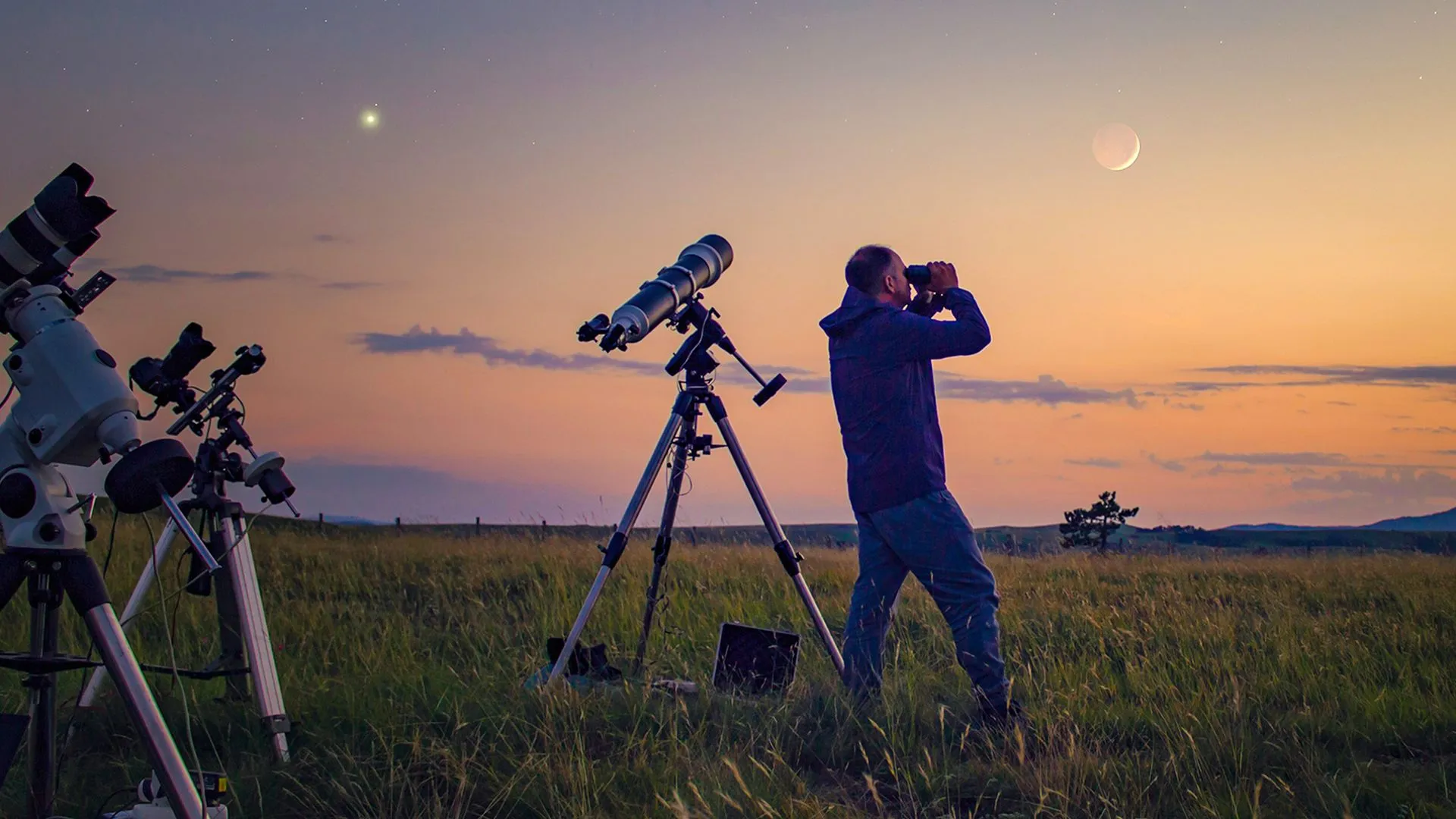 Man observing the night sky with a good backyard telescope setup
Man observing the night sky with a good backyard telescope setup
The best telescopes offer up stunning views of the night sky. (Image credit: Getty)
This guide covers a range of telescopes, from affordable options ideal for novice skywatchers to powerful instruments suitable for experienced astronomers and serious astrophotography. We’ve tested these models for their observational capabilities, ease of setup and use, and overall value, focusing on what makes a telescope particularly well-suited for use from your home or local observing spot.
Top Recommendations for a Good Backyard Telescope in 2025
Here are some of the best telescopes we recommend for backyard astronomy enthusiasts of all levels.
Best for Beginners
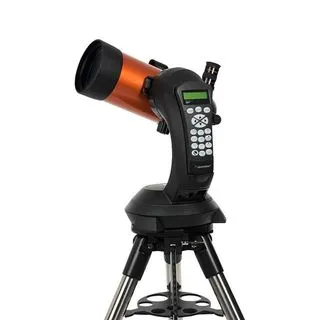 Celestron NexStar 4SE, a computerized good backyard telescope for beginners
Celestron NexStar 4SE, a computerized good backyard telescope for beginners
Where to Go After Las Vegas? Top Road Trips & Destinations
In our full review of the Nexstar 4SE, we found it was quick and easy to set up, perfect for beginners who want a quality go-to telescope.(Image credit: Jonathan Lansley-Gordon)
Celestron NexStar 4SE
Best for finding planets: It can find celestial objects easily with Celestron’s SkyAlign technology.
Our expert review:
| Specifications | Notes |
|---|---|
| Optical design | Maksutov-Cassegrain |
| Mount type | Computerized Alt-Azimuth |
| Aperture | 4-inches / 102mm |
| Focal length | 1325mm |
| Highest useful magnification | 241x |
| Lowest useful magnification | 15x |
| Supplied eyepieces | 25mm |
| Weight | 23 lbs (10.44kg) fully assembled |
Reasons to buy
- Uncomplicated, quick setup
- Auto finds night sky objects
- High quality, sturdy build
- No collimation required
Reasons to avoid
- Narrow field of view
- Not very portable
- Limited accessories supplied
Buy it if:
✅ It’s your first telescope: This scope is easy to use and set up, making it perfect for beginner astronomers.
✅ You want GoTo technology: You can easily find and track specific celestial objects with little or no prior knowledge.
Don’t buy it if:
❌ You want to travel with it: This telescope isn’t the most portable as the tripod doesn’t fold down entirely.
The bottom line:
🔎 Celestron NexStar 4SE: If you want to view the planets and bright objects in the sky quickly and effortlessly, the Celestron NexStar 4SE will certainly do the job. ★★★★
The Celestron NexStar 4SE is a fantastic choice for beginners looking for a good backyard telescope thanks to its fully computerized mount and Celestron’s SkyAlign technology. This feature identifies your location, date, and time to automatically locate various targets in the night sky with the push of a button, simplifying the process for newcomers to stargazing.
With a 4-inch (102mm) aperture and a focal length of 1,325mm, this telescope provides sharp views of planets and other bright celestial objects. However, its narrow field of view (1.2 degrees) means larger deep-sky objects might not fit entirely into your view. The included 25mm Plossl eyepiece is functional, but adding a 32mm eyepiece and a Barlow lens can enhance performance up to the 241x highest useful magnification.
The NexStar 4SE boasts a sturdy design, contributing to its 23 lbs (10.4 kg) weight. While this provides stability, its tripod doesn’t fold completely, limiting its portability compared to lighter models. This makes it better suited for stargazing from a fixed backyard location rather than frequent travel. It’s also quite power-hungry, quickly draining 8xAA batteries, so an external power source is highly recommended for longer observing sessions at home.
| Attributes | Notes |
|---|---|
| Design | Solid and sturdy build, signature orange colors. |
| Performance | Great for observing the moon and planets. |
| Functionality | Alignment correction can be tricky. |
Best Budget Telescope
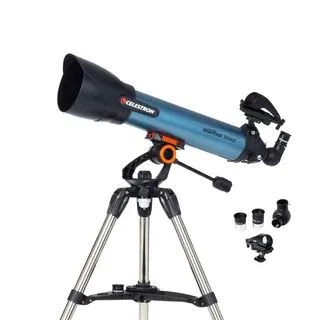 Celestron Inspire 100AZ, a budget-friendly good backyard telescope option
Celestron Inspire 100AZ, a budget-friendly good backyard telescope option
The Celestron Inspire 100AZ comes with a plethora of helpful accessories, but after our full review, we’d recommend updating the eyepieces.(Image credit: Jamie Carter)
Celestron Inspire 100AZ Refractor
Best budget telescope for budding skywatchers who want to get up and running quickly
Our expert review:
| Specifications | Notes |
|---|---|
| Optical design | Refractor |
| Mount type | Alt-azimuth |
| Aperture | 3.94-inches / 100mm |
| Focal length | 660mm |
| Highest useful magnification | 241x |
| Lowest useful magnification | 15x |
| Supplied eyepieces | 10mm, 25mm |
| Weight | 20 lbs (9.07kg) |
Reasons to buy
- Sharp views of planets and the moon
- Handy smartphone adaptor
- Built-in red light
- Lightweight frame
Reasons to avoid
- Bearings lack precision
- Some chromatic aberration
- No solar observing possible
Buy it if:
✅ You’re a beginner: We found it easy to set up and take down, perfect for beginners.
✅ You want to take astro shots on your smartphone: The lens cap cleverly turns into a smartphone holder so you can capture images of the night sky.
Don’t buy it if:
❌ You aren’t confident locating objects yourself: This telescope doesn’t have GoTo technology, so you’ll need to be able to locate specific celestial objects yourself (or with the help of a stargazing app).
❌ You want detailed views of deep sky objects: While this telescope can give great views of planets and the moon, objects further away may appear a little underwhelming.
The bottom line:
🔎 Celestron Inspire 100az: Aimed at beginners and those looking to upgrade, this 4-inch refractor performs best with the moon and planets. It comes with a lens cap that converts to a smartphone holder for easy astrophotography. ★★★★
For those seeking a good backyard telescope that’s both affordable and easy to use, the Celestron Inspire 100AZ is an excellent choice. Its user-friendly design and sturdy build make it ideal for newcomers to astronomy.
This achromatic refractor features a 4-inch/100mm aperture and a 660mm focal length, optimized for viewing planets, the moon, and brighter deep-sky objects from a home setting. It sits on a simple altazimuth mount for straightforward up/down and side-to-side movement.
The 100mm aperture gathers ample light for clear observations, and the focal length provides good magnification for detailed planetary views. During testing, we noted minor false color (purple fringing) and slight blurring at the field edges. Upgrading the included 10mm and 25mm Kellner eyepieces with better quality ones can significantly improve the views. While the false color exists, it’s usually not a major issue for casual observers.
A notable feature for modern stargazers is the included lens cap that cleverly transforms into a smartphone adapter, making basic astrophotography accessible. The telescope also comes with a red LED flashlight for preserving night vision and a StarPointer Pro finderscope for locating objects. Its lightweight frame adds to its appeal for backyard use or short trips away.
| Attributes | Notes |
|---|---|
| Design | Fairly lightweight. |
| Performance | Excels with lunar views. |
| Functionality | Easy to set up and take down. |
Best Value for Enthusiasts
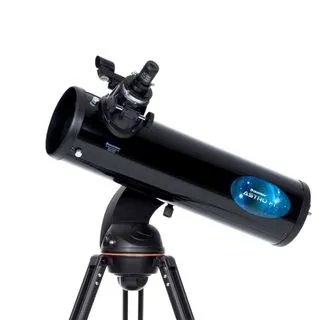 Celestron Astro Fi 130, a good backyard telescope with WiFi connectivity
Celestron Astro Fi 130, a good backyard telescope with WiFi connectivity
The Celestron Astro Fi 130’s wide field of view will allow you to see large galaxies without having to reposition the telescope often. (Image credit: B&H Photo)
Celestron Astro Fi 130
Best value enthusiast telescope: A guide to the night sky, packed with technology at a low price
Our expert review:
| Specifications | Notes |
|---|---|
| Optical design | Newtonian Reflector |
| Mount type | Computerized altitude-azimuth single fork |
| Aperture | 5.19-inches / 130mm |
| Focal length | 650mm |
| Highest useful magnification | 307x |
| Lowest useful magnification | 19x |
| Supplied eyepieces | 25mm and 10mm |
| Weight | 18 lbs (8.6kg) |
Reasons to buy
- Suitable for low budgets
- Great entry-level telescope
- Vixen dovetail for mount changes
- Portable
- Computer recommends targets
- Finds targets at touch of button
Reasons to avoid
- Eyepieces limit observations
- Focuser of low quality
- Battery drains quickly
- Useless without app
Buy it if:
✅ You want a beginner-friendly, grab & go, easy-to-use telescope: We thought this was a great entry-level telescope that can find targets at the touch of a button and is great for on-the-go observations.
Don’t buy it if:
❌ You want a ‘traditional’ telescope: We found this telescope is completely useless without the app, so if you want a more traditional telescope without much of the newer technology, look elsewhere.
The bottom line:
🔎 Celestron Astro Fi 130: A good telescope at an exceptionally good price, it has everything you’d need if you’re just starting out, although we would recommend upgrading some of the pieces included. It can lose charge quickly in cold conditions, though, so consider buying an additional power source. ★★★½
The Celestron Astro Fi 130 stands out as a good backyard telescope offering impressive value, particularly for those starting their astronomical journey with a bit more enthusiasm. This Newtonian reflector combines a sturdy build with technological features at an affordable price point.
Equipped with a 5.19-inch/130mm aperture and a 650mm focal length, the Astro Fi 130 is capable of providing satisfying views. While the included 10mm and 25mm Kellner eyepieces are functional, upgrading to mid-range Plossl eyepieces is recommended to fully utilize the scope’s potential. The computerized alt-azimuth mount, controlled via the Celestron SkyPortal app on your smartphone or tablet, simplifies navigation. The app’s SkyAlign technology allows for easy setup without prior knowledge of the night sky and can even recommend celestial targets.
Portability is a plus for backyard astronomers who might want to move the telescope around. However, like some other computerized models, it can drain batteries quickly, especially in colder weather, making rechargeable batteries or an external power source a sensible investment for extended observing sessions at home.
The Astro Fi 130 delivers good views of the moon’s surface features and makes it easy to locate planets like Venus and Mars. It’s even capable of revealing fainter objects like the Andromeda Galaxy under favorable conditions. While the focuser quality isn’t top-tier and the telescope relies entirely on the app for functionality, its combination of features, performance, and price makes it a compelling choice for enthusiasts seeking good value. It serves as an excellent hobby telescope that leverages modern tech.
| Attributes | Notes |
|---|---|
| Design | Very sturdy build with well constructed tube and tripod. |
| Performance | Makes use of SkyAlign technology for easy alignment. |
| Functionality | Great for lunar and planetary observing, but some views are fuzzy. |
Best Premium
 Celestron NexStar Evolution 9.25, a premium good backyard telescope for detailed views
Celestron NexStar Evolution 9.25, a premium good backyard telescope for detailed views
Automatically track objects as they move across the sky with this high-quality Catadioptric telescope. (Image credit: B&H Photo)
Celestron NexStar Evolution 9.25
Best GoTo scope for seeing the universe in HD, but it has a premium price point
Our expert review:
| Specifications | Notes |
|---|---|
| Optical design | Schmidt-Cassegrain |
| Mount type | Computerized alt-azimuth fork arm |
| Aperture | 9.25-inches / 235mm |
| Focal length | 2350mm |
| Highest useful magnification | 555x |
| Lowest useful magnification | 34x |
| Supplied eyepieces | 13mm, 40mm |
| Weight | 62.60 lbs (28.39kg) |
Reasons to buy
- Crisp views with no defects
- Easy to set up
- High-quality design
Reasons to avoid
- Isn’t very portable — best for backyard star gazing
- Expensive
Buy it if:
✅ You want to view a wide range of subjects: This scope has a large aperture which enables clear and detailed views of a wide range of celestial objects, including planets, deep-sky objects and nebulas.
✅ You’re an experienced skywatcher: Although its easy setup is a dream for beginners, this scope is best suited for more advanced, passionate astronomers who want a full view of the universe.
Don’t buy it if:
❌ You want something portable: Portability isn’t one of the Evolution 9.25’s strengths, so it’s best used for backyard gazing.
The bottom line:
🔎 Celestron NexStar Evolution 9.25: A fantastic telescope best suited to experienced skywatchers, with a price tag to match its premium features. It’s not the easiest to transport, but we think it’s one of the best GoTo telescopes you can buy ★★★★½
For the serious amateur astronomy telescope user or enthusiast willing to invest in exceptional quality for their home observatory, the Celestron NexStar Evolution 9.25 is a top contender. This premium Schmidt-Cassegrain telescope delivers breathtaking views with impressive clarity.
Featuring a substantial 9.25-inch (235mm) aperture and a 2350mm focal length, this telescope is capable of resolving fine details on planets and providing bright views of deep-sky objects. The robust computerized alt-azimuth fork arm mount ensures stability and precise tracking, essential for both visual observation and astrophotography from your backyard setup.
A key advantage for extended backyard use is the built-in rechargeable lithium-ion battery, providing up to 10 hours of power. Control is seamlessly handled via the free Celestron SkyPortal app, eliminating the need for a physical hand controller during sessions. While the initial setup is straightforward thanks to Celestron’s technology, the telescope’s considerable weight (62.60 lbs / 28.39kg) makes it less portable. It’s truly designed as a high-performance good backyard telescope meant to be used primarily from a fixed location. It comes with quality accessories, including 13mm and 40mm eyepieces.
| Attributes | Notes |
|---|---|
| Design | A bit bulky and tricky to transport. |
| Performance | Crisp views with no defects. |
| Functionality | Motorized mount a good choice for astrophotography. |
Best for Astrophotography
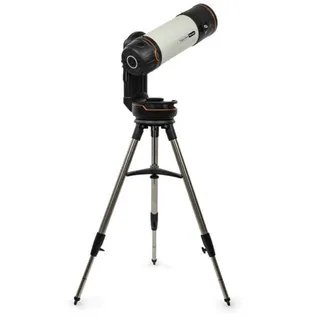 Celestron Origin Intelligent Home Observatory, a smart good backyard telescope for astrophotography
Celestron Origin Intelligent Home Observatory, a smart good backyard telescope for astrophotography
This smart telescope takes beautiful deep sky photos in just a few seconds, but it’s not an all-rounder telescope.
Celestron Origin Intelligent Home Observatory
Best for astrophotography: This smart telescopes can take clear photos of deep sky objects in seconds
Our expert review:
| Specifications | Notes |
|---|---|
| Optical design | Rowe-Ackermann Schmidt Astrograph (RASA) |
| Mount type | Motorized Alt-azimuth |
| Aperture | 6-inches / 152mm |
| Focal length | 335mm |
| Highest useful magnification | N/A |
| Lowest useful magnification | N/A |
| Supplied eyepieces | N/A |
| Weight | 41.6 lbs (18.6 kg) |
Reasons to buy
- Crystal clear deep sky photos in seconds
- Quick set up
- Easy-to-use, helpful app
- Stacks and processes images automatically
Reasons to avoid
- Not ideal for all celestial objects
- Quite large and heavy
Buy it if:
✅ You want an automated telescope: Focusing, tracking, finding targets and stacking processed images is all automatic with this one.
✅ You want to take deep sky images: The Origin can do this and more in just a few minutes, with little pre-knowledge required.
Don’t buy it if:
❌ You want a traditional telescope: This one doesn’t have an eyepiece and only gives you views of the night sky on a mobile device.
❌ You’re on a budget: At around $4,000, this telescope is on the pricier side.
The bottom line:
🔎 Celestron Origin Intelligent Home Observatory: This (pricey) smart telescope can do every part of stargazing autonomously, and produces beautiful photos of the night sky in seconds. ★★★★½
For astrophotography enthusiasts who prioritize ease of use and rapid results from their good backyard telescope, the Celestron Origin Intelligent Home Observatory is a revolutionary smart telescope. Unlike traditional scopes, it features a built-in camera instead of an eyepiece, allowing you to view and image the night sky directly on your mobile device.
Based on the RASA optical design with a 6-inch (152mm) aperture and a 335mm focal length, the Origin excels at capturing stunning, clear images of deep-sky objects and distant galaxies in mere seconds, even from light-polluted urban areas. Its automated processes handle focusing, tracking, target acquisition, and image stacking, making complex astrophotography accessible even without prior experience.
While it delivers spectacular deep-sky photos and is incredibly easy to set up and control via its intuitive app, we found it less suited for planetary imaging during testing. Its reliance on a mobile device for viewing means it doesn’t offer the traditional eyepiece experience. Furthermore, its size and weight (41.6 lbs / 18.6 kg) make it less portable than some other options, cementing its role as a home observatory tool. The premium price tag reflects its advanced technology and capabilities.
| Attributes | Notes |
|---|---|
| Design | Bulky, but full of useful features on the mount. |
| Performance | Beautiful, clear photos of deep sky objects. |
| Functionality | Motorized mount, but not a traditional telescope with an eyepiece. |
Best Motorized Telescope
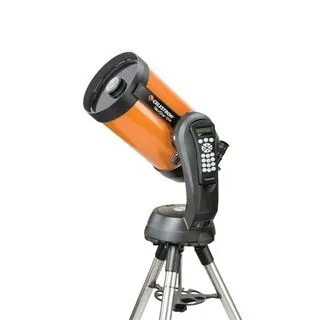 Celestron NexStar 8SE, a popular motorized good backyard telescope
Celestron NexStar 8SE, a popular motorized good backyard telescope
A fantastic scope for any experience level, incredibly easy to use yet powerful enough for deep space exploration and even astrophotography.
Celestron NexStar 8SE
Best motorized scope: Ideal for astrophotography and deep space observing, giving excellent image clarity and detail
Our expert review:
| Specifications | Notes |
|---|---|
| Optical design | Schmidt-Cassegrain |
| Mount type | Computerized alt-azimuth fork arm |
| Aperture | 8-inches / 203mm |
| Focal length | 2032mm |
| Highest useful magnification | 480x |
| Lowest useful magnification | 29x |
| Supplied eyepieces | 25mm |
| Weight | 32 lbs (14.48kg) |
Reasons to buy
- Incredibly bright views
- Sharpness across the entire field of view
- Pricey, but good value for money
Reasons to avoid
- Will price some beginners out
- Slewing using the remote is a little laggy, but not much
Buy it if:
✅ You’re looking for a long-term telescope: There’s no question that this telescope is pricey, but it’s one that will last you for decades — it’s not called ‘The World’s Most Beloved Telescope’ for nothing.
✅ You want to use it for astrophotography: Thanks to the smooth and accurate tracking, this scope is a great option for taking stunning astro images of deep sky objects.
Don’t buy it if:
❌ You’re on a budget: Although this is definitely worth the money and we’d recommend it if your budget can stretch to it, it is very pricey. If you’re on a budget or you’re new to the medium, there are plenty of cheaper alternatives that will be more than good enough.
The bottom line:
🔎 Celestron NexStar 8SE: An outstanding telescope with incredible optics that would suit a beginner, intermediate or advanced astronomer. It’s great for astrophotography and gives beautifully bright and detailed views. Our only fault with it is that it can price out beginners. ★★★★½
Often hailed as “The World’s Most Beloved Telescope,” the Celestron NexStar 8SE is an incredibly versatile and good backyard telescope suitable for astronomers of all levels. Its blend of user-friendliness and powerful optics makes it a long-term investment.
This 8-inch Schmidt-Cassegrain telescope, with a 2032mm focal length, gathers a vast amount of light, providing stunningly bright and clear views of objects within and beyond our solar system. Its catadioptric design allows for a relatively compact tube despite the long focal length, contributing to decent portability.
The motorized alt-azimuth fork arm mount is a major highlight. Combined with Celestron’s SkyAlign, setup is simple – align using three bright stars, and the telescope automates the rest. The handheld remote (or optional app control) gives access to a large database of celestial objects, making navigation effortless for exploring your backyard sky. The smooth and accurate tracking of the motorized mount also makes it a great option for astrophotography. While the initial cost is higher, its performance and durability offer excellent value over time. Its need for 8x AA batteries suggests rechargeable batteries are a must for regular backyard use.
| Attributes | Notes |
|---|---|
| Design | Can be transported as a fully-assembled setup. |
| Performance | Outstanding optics, slightly tricky to align if you’re not used to it. |
| Functionality | Easy to assemble and disassemble. |
Best for Portability
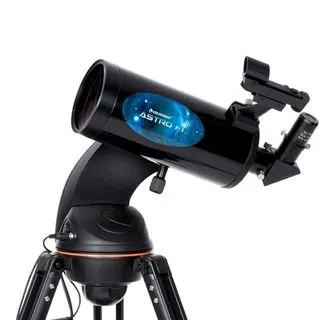 Celestron Astro Fi 102, a lightweight good backyard telescope for portability
Celestron Astro Fi 102, a lightweight good backyard telescope for portability
If you live in an urban area with lots of light pollution and need a telescope you can comfortably carry to dark sky sites, this could be the one for you.
Celestron Astro Fi 102
Best lightweight and portable go-to mount scope for beginner sky watchers
Our expert review:
| Specifications | Notes |
|---|---|
| Optical design | Maksutov-Cassegrain |
| Mount type | Computerized Alt-Azimuth Single Fork Arm |
| Aperture | 4.0-inches / 102mm |
| Focal length | 1325mm |
| Highest useful magnification | Up to 100x with digital zoom |
| Lowest useful magnification | 15x |
| Supplied eyepieces | 25mm and 10mm |
| Weight | 6 lbs (2.7kg) |
Reasons to buy
- Very portable thanks to its lightweight design
- Reasonably and fairly priced
- No prior experience needed
Reasons to avoid
- Optics could be better
- Tripod isn’t the best quality
- Doesn’t feel like a premium product to the touch
Buy it if:
✅ You’ll be traveling with it: This scope is our top choice for portability, so it’s ideal if you plan on taking it away on camping trips or to areas with darker skies.✅ You’re a beginner: If you just want to look at the moon and some planets, this is a great choice.
Don’t buy it if:
❌ You want good quality parts: This telescope has an element of ‘you get what you pay for’. It’s adequate for basic astronomy, but the tripod isn’t the best quality, the optics could be better and it didn’t have a premium feel.
The bottom line:
🔎 Celestron Astro Fi 102: Best suited for viewing the moon and planets, this telescope is great for beginners and anyone with no prior experience. It can be a little tricky to setup initially, and it’s not the best quality scope we’ve reviewed, but it’ll do the job. ★★★½
For backyard astronomers living in light-polluted areas or those who value mobility, the Celestron Astro Fi 102 is an excellent, lightweight, and good backyard telescope option. Its primary strength lies in its portability, making it easy to transport to darker observing sites or simply move around your yard.
This Maksutov-Cassegrain telescope weighs only 6 lbs (2.7kg) and features a compact body. It includes integrated WiFi for control via the Celestron SkyPortal app, which boasts a database of approximately 100,000 celestial objects, simplifying target location for beginners without prior sky knowledge. The computerized mount automatically slews to your chosen target.
While the Astro Fi 102 is affordable and convenient, especially for viewing the moon and brighter planets like Mars, Saturn, and Jupiter, its optical quality isn’t the best, with some sharpness drop-off at the edges. The included tripod also feels somewhat flimsy and might need extra weighting for stability. Despite these points, its ease of setup, automated features, and impressive portability make it a solid choice for casual backyard stargazing or a hobby telescope you can easily take on the go.
| Attributes | Notes |
|---|---|
| Design | Highly transportable, but tripod needs weighing down. |
| Performance | Initial setup can be tricky, but after that it’s a breeze. |
| Functionality | Large database of celestial objects on SkyPortal. |
Best for Accessories
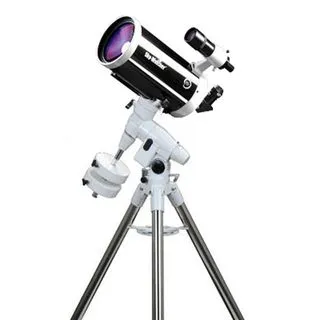 Sky-Watcher Skymax 150 PRO, a good backyard telescope suitable for astrophotography
Sky-Watcher Skymax 150 PRO, a good backyard telescope suitable for astrophotography
This telescope is suitable for capturing everything from nebulas to galaxies. It has outstanding optical quality with no signs of distortion, and can accommodate plenty of accessories.
Sky-Watcher Skymax 150 PRO
Best for accessories: The Skymax 150 PRO can accommodate CCD or DSLR cameras, filter wheels and other add-ons
Our expert review:
| Specifications | Notes |
|---|---|
| Optical design | Maksutov-Cassegrain |
| Mount type | Equatorial (EQ-5 Pro) |
| Aperture | 5.90-inches / 150mm |
| Focal length | 1800mm |
| Highest useful magnification | 450x |
| Lowest useful magnification | 36x |
| Supplied eyepieces | 28 mm |
| Weight | 13.23 lbs (6kg) |
Reasons to buy
- High-quality, lightweight build
- Excellent optics
- Great for a wide selection of astrophotography
Reasons to avoid
- Not all models come with a tripod
- Comes with only one eyepiece
Buy it if:
✅ You want to travel with it: Most astrophotography involves traveling to dark sky sites, and this telescope is light enough to do just that.
✅ Your primary focus is astrophotography: We recommend this telescope as the best for astrophotography thanks to its amazing optics.
Don’t buy it if:
❌ You’re looking for something super sophisticated: For those looking for high-end, sophisticated instruments and have the money to spend on them, a smart telescope would likely be a better fit.
The bottom line:
🔎 Sky-Watcher Skymax 150 PRO: This telescope is perfect for astrophotographers who want to take it on shoots — it has great quality optics and an excellent build. It can accommodate plenty of accessories, although not all models come with a tripod. ★★★★
For the serious amateur astronomy telescope user who enjoys customizing their setup and diving into astrophotography, the Sky-Watcher Skymax 150 PRO is designed with expandability in mind. This Maksutov-Cassegrain telescope, weighing just 13.23 lbs (6kg), combines excellent optics with a build quality that welcomes a variety of accessories.
Featuring a 5.90-inch (150mm) aperture and an 1800mm focal length, the Skymax 150 PRO delivers crisp, distortion-free views suitable for both visual observation and capturing images. Its compatibility with an equatorial mount (like the EQ-5 Pro) makes it ideal for tracking celestial objects during long-exposure astrophotography.
What sets this telescope apart as a versatile good backyard telescope is its capacity to accommodate additional gear such as CCD or DSLR cameras, filter wheels, and more. It includes a Vixen-style dovetail plate for easy mount attachment. While it comes with only one 28mm eyepiece, its smooth focuser and optical quality make it a joy to use and customize for specific observing or imaging tasks, whether planets or deep-sky targets. Its relatively lightweight design is a bonus for transporting it to darker sites if needed, though note that some packages may require purchasing a tripod separately.
| Attributes | Notes |
|---|---|
| Design | High quality build, excellent optics. |
| Performance | Outstanding optics, with no sign of distortion. |
| Functionality | Great for a wide selection of astrophotography. |
Best Smart Telescope
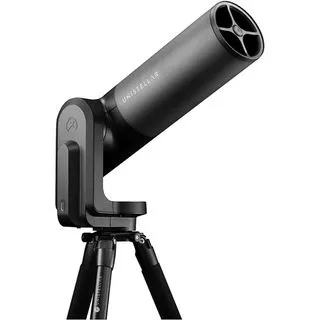 Unistellar eQuinox 2 smart telescope, an urban-friendly good backyard telescope
Unistellar eQuinox 2 smart telescope, an urban-friendly good backyard telescope
If you’ve got the budget for it, this is Unistellar’s most advanced telescope to date. It has a very reliable app and features a Smart Light Reduction feature to eliminate light pollution in urban environments.
Unistellar eQuinox 2 telescope
Best smart telescope: This smart telescope offers simple astronomy powered by a clever smartphone app
Our expert review:
| Specifications | Notes |
|---|---|
| Optical design | Newtonian Reflector |
| Mount type | Motorized GoTo alt-azimuth |
| Aperture | 4.49-inches / 114mm |
| Focal length | 450mm |
| Highest useful magnification | 400x digital |
| Lowest useful magnification | 50x optical |
| Supplied eyepieces | N/A |
| Weight | 19.8 lbs (9kg) |
Reasons to buy
- Beautiful, simple layout and design
- Get views of the night sky fast
- App is easy to operate
Reasons to avoid
- Image resolution is average
- Can’t orientate telescope in twilight
- Laggy views when focusing
Buy it if:
✅ You live in an urban area: This scope has a Smart Light Pollution Reduction feature that removes light pollution, s it’s a great option if you don’t live near a dark sky site.
✅ You want simplicity: This is an incredibly sleek, all-in-one telescope that has no need for additional accessories and can take you to your chosen celestial objects with ease.
Don’t buy it if:
❌ You’re on a budget: Unsurprisingly, this is an expensive bit of kit, so it’ll price out most beginners and anyone who doesn’t have a big budget.
The bottom line:
🔎 Unistellar eQuinox 2: An easy-to-use motorized smart telescope that can locate night sky objects at the push of a button, the eQuinox 2 can have you exploring the stars in minutes without the need for prior knowledge, although its in-built camera isn’t quite detailed enough. ★★★★½
For the tech-savvy backyard astronomer, the Unistellar eQuinox 2 redefines the experience of using a good backyard telescope. This smart telescope, with its sleek design and app-driven functionality, simplifies exploring the night sky, particularly benefiting those in urban environments.
The eQuinox 2 is a motorized Newtonian reflector controlled entirely via the Unistellar app – it notably lacks an eyepiece. Its 4.49-inch (114mm) aperture and 450mm focal length are paired with a 6.2MP image sensor that captures and stacks multiple images in real-time, enhancing brightness and detail on your connected device. This stacking process, combined with the Smart Light Pollution Reduction feature, makes it exceptionally effective for observing fainter objects from areas with significant light pollution.
Setup is quick thanks to the Autonomous Field Detection. The intuitive app allows easy navigation through a vast database of stars and objects, guiding the telescope to your chosen target automatically. While the image resolution isn’t the highest compared to traditional setups with dedicated astrophotography cameras, the ease of use and ability to capture images quickly and share them easily are major draws. Weighing 19.8 lbs (9kg), it’s moderately portable for a smart telescope, but its premium price point makes it an investment for those prioritizing convenience and urban stargazing capabilities in their hobby telescope.
| Attributes | Notes |
|---|---|
| Design | Slim, sleek, neat package. |
| Performance | Quick go to location of night sky objects. |
| Functionality | Doesn’t orientate until well after twilight, easy once oriented. |
Best for Deep Space
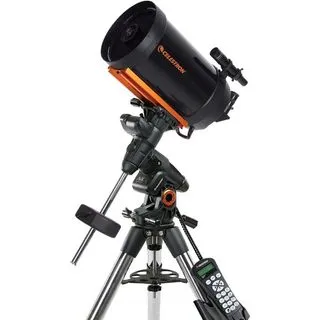 Celestron Advanced VX 8 EdgeHD, a good backyard telescope for experienced astronomers
Celestron Advanced VX 8 EdgeHD, a good backyard telescope for experienced astronomers
Great for experienced, long-time astronomers, this scope is excellent for astrophotography thanks to the Edge HD technology. It’s a little on the heavy side, but it can carry a load of up to 30 lbs.
Celestron Advanced VX 8 EdgeHD
Best for pinpoint sharpness across the whole field of view, this is one for veteran astronomers
Our expert review:
| Specifications | Notes |
|---|---|
| Optical design | Schmidt-Cassegrain |
| Mount type | Motorized equatorial |
| Aperture | 8-inches / 203.2mm |
| Focal length | 2032mm |
| Highest useful magnification | 480x |
| Lowest useful magnification | 29x |
| Supplied eyepieces | 40mm |
| Weight | 61 lbs (27.67kg) |
Reasons to buy
- EdgeHD has the best optics available in a telescope of this size
- Computerized mount finds and tracks objects reliably
- Dovetail mount system
- Proven design on the market for years, incrementally refined
Reasons to avoid
- Setting up requires some knowledge of the sky
- Only one eyepiece is supplied
- Needs a sturdier mount for serious long-exposure photography
Buy it if:
✅ You want to see everything: While some telescopes are only good for seeing the moon and planets or deep space, this telescope is good for seeing all types of celestial objects.
✅ You want a seamless experience: We found the motorized mount on this telescope very smooth and slick.
Don’t buy it if:
❌ You’re a beginner: This telescope is intended for those with experience and knowledge of the sky and telescopes, so if you’re just starting out, we’d suggest a more beginner-friendly model.
❌ You want something lightweight: At 61 lbs (27.67kg), this telescope is heavier than most other choices in this guide.
The bottom line:
🔎 Celestron Advanced VX 8 EdgeHD: Intended for serious amateurs, this optically excellent telescope is suitable for all types of visual astronomy with its rugged, lightweight computerized mount. If you know the sky and plan to be doing astronomy for a long time, this is the telescope to get. ★★★★½
For the dedicated amateur astronomy telescope user seeking exceptional optical performance, particularly for deep-sky objects and astrophotography, the Celestron Advanced VX 8 EdgeHD is a powerful instrument. This system combines Celestron’s renowned EdgeHD optics with a capable equatorial mount, making it a top-tier good backyard telescope for serious observers.
The 8-inch (203.2mm) EdgeHD optical tube is the star here, specifically designed to eliminate field curvature and coma, delivering pinpoint sharp stars across the entire field of view – a critical advantage for astrophotography. With a 2032mm focal length, it offers high magnification capabilities for detailed views of planets, while the 8-inch aperture gathers enough light to reveal faint galaxies and nebulas.
Mounted on the Advanced VX equatorial mount, this telescope system allows for precise tracking aligned with the celestial pole, essential for long-exposure imaging. The computerized GoTo capabilities, controlled via the NexStar+ hand controller or SkyPortal app, reliably find and track objects. While the mount is sturdy and designed for astrophotography, some serious imagers might opt for an even heavier-duty mount. At 61 lbs (27.67kg), the system is heavy and less portable, best suited for setting up in a dedicated backyard observing space. This telescope is an investment designed for long-term use and growth in the hobby.
| Attributes | Notes |
|---|---|
| Design | EdgeHD optical design outperforms Schmidt-Cassegrain. |
| Performance | Finds and tracks celestial objects reliably. |
| Functionality | Great views of all types of celestial objects. |
Best for Kids
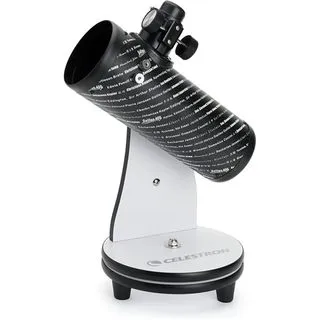 Celestron FirstScope 76 Tabletop, a good backyard telescope for kids and beginners
Celestron FirstScope 76 Tabletop, a good backyard telescope for kids and beginners
This is a great tabletop telescope and an ideal starting point for beginners and young astronomers. It’s easy to set up and put away, but it’s not the most powerful.
Celestron FirstScope 76 Tabletop telescope
Best tabletop telescope suited to on-the-go astronomers with small hands
Our expert review:
| Specifications | Notes |
|---|---|
| Optical design | Reflector |
| Mount type | Dobsonian |
| Aperture | 2.99-inch / 76mm |
| Focal length | 11.81-inch / 300mm |
| Highest useful magnification | 180x |
| Lowest useful magnification | 11x |
| Supplied eyepieces | 4mm, 20mm |
| Weight | 4.5 lbs / 2.04kg |
Reasons to buy
- Portable
- Easy to use
- Robust build
- Low investment for casual or young astronomers
- Fast focal ratio for easy observations of wide-angle targets
Reasons to avoid
- Loose focuser
- Some observations lack clarity and detail
- A challenge to collimate
- Finderscope not supplied
Buy it if:
✅ You want low investment: For casual viewing, this telescope is a great option with a low price point.
✅ You don’t want to spend ages setting it up: It arrives assembled and ready to go, so no complicated setup process needed.
Don’t buy it if:
❌ You want to find objects easily: It doesn’t come with a finderscope, so anyone wanting to locate certain celestial objects easily may get frustrated.
❌ You want all the extras: This package doesn’t include a finderscope, so you’ll need to either buy one separately or consider another telescope package that does.
The bottom line:
🔎 Celestron FirstScope 76 Tabletop Telescope: If you have children who have been bugging you for a telescope and you can’t quite commit to a moderately-priced instrument, then the FirstScope may be for you — especially if the moon and casual glances at the night sky are of interest. ★★★★
Introducing children or new users to the wonders of the cosmos from the backyard requires a telescope that is simple, robust, and delivers engaging views without complexity. The Celestron FirstScope 76 Tabletop telescope is a fantastic good backyard telescope specifically designed for this purpose.
This 76mm reflector arrives fully assembled, ready for immediate use – perfect for impatient young astronomers. Its tabletop Dobsonian mount is intuitive and easy to maneuver, allowing users to simply push the tube to the desired target. The 76mm aperture and fast f/3.95 focal ratio provide wide-angle views capable of showing lunar craters and even some brighter deep-sky targets, offering that initial “wow factor.” While not providing high-definition detail or significant magnification, the views are more than sufficient for casual observation.
Weighing only 4.5 lbs (2.04kg), the FirstScope is highly portable and easily placed on a sturdy table in the backyard. Its durable, non-glossy plastic construction feels surprisingly premium and is built to withstand handling. The main drawback is the absence of a finderscope, which can make locating specific objects challenging for beginners. However, adding an inexpensive red dot finder significantly improves the experience. This telescope represents a low-investment entry point into the hobby, perfect for sparking interest in the night sky from the convenience of your home.
| Attributes | Notes |
|---|---|
| Design | Good quality build for the price. |
| Performance | Provides a ‘wow factor’ for young observers. |
| Functionality | Optics struggle to pick out detail. |
Telescope FAQ
Choosing the right telescope, especially a good backyard telescope, involves understanding various types and features. Here are some frequently asked questions answered by Dr Gemma Lavender, a contributing expert.
Telescope FAQ answered by Dr Gemma Lavender, Contributing expert to Space.com
How do I choose the right telescope for me?
Choosing the perfect telescope can be challenging, particularly for a beginner. The market offers hundreds of options with varying configurations, settings, and prices, often surrounded by technical jargon.
The good news is that telescope quality has improved significantly in recent years, so most models are quite good. However, some are better suited for backyard use than others. When selecting a good backyard telescope, the most critical factor is optical quality. Consider the aperture needed based on what you want to observe (planets, moon, deep sky objects). Portability is also key if you plan to move it around your yard or to darker sites. For newcomers, looking at dedicated beginner telescopes is a brilliant starting point.
Think about your observing location – is light pollution an issue? This can influence the type of telescope or features you need. Consider your setup preferences; do you want something quick and easy or a system you can grow with? If astrophotography is a goal, look for models with suitable mounts and capabilities.
Purchasing from reputable telescope dealers is highly recommended. They ensure you receive exactly what you ordered, often provide warranties, and their advisors can offer valuable guidance tailored to your needs as a backyard astronomer.
What types of telescope are there?
There are three main types of telescopes: reflector, refractor, and catadioptric.
Reflectors use mirrors to gather and focus light, while refractors use lenses. Catadioptrics combine both mirrors and lenses. Each type has sub-types with design variations. Newtonian design is common for basic reflectors, using a main mirror and a smaller secondary mirror to direct light to the eyepiece.
For those seeking a good backyard telescope, the choice often depends on priorities. Newtonian reflector telescopes on a simple undriven alt-azimuth mount (known as a ‘Dobsonian’) often offer great value for their aperture size, gathering a lot of light for observing faint objects. This type of hobby telescope requires manual navigation, ideal if you enjoy using star maps to learn the sky “the old fashioned way”. Dobsonians can be large, so storage in a garage or shed might be necessary for larger apertures (over 6 inches).
Adding an equatorial or computerized mount increases the price but significantly enhances functionality, particularly for tracking objects or astrophotography. Computerized mounts range from “push-to” (guides you manually) to “GoTo” (motorized, finds objects automatically). A computerized GoTo Dobsonian or Newtonian can be excellent for easier navigation from your yard.
If ease of use, portability, and modern features appeal to you, a short focal length refractor (up to 4 inches) or a catadioptric (like a Schmidt- or Maksutov-Cassegrain up to 5 inches) on a computerized mount could be a good fit. These versatile telescopes offer high magnification for detailed views of the moon and planets.
Achromatic refractors can show false color around bright objects due to how they focus light. Maksutovs are better at correcting this but are generally more expensive. Apochromatic refractors offer the best color correction but come at a premium price. When choosing a good backyard telescope, balance these factors with your budget and observing preferences.
Refractors are usually supplied with a simple alt-azimuth mount that allows you to slew from left to right and up and down. (Image credit: Amazon)
How does a refractor telescope work?
Refractors bend (refract) light using lenses. They typically have an objective lens at the front and a star diagonal with an eyepiece at the back. This design is straightforward, making refractors low-maintenance and easy to set up, which is great for a good backyard telescope for beginners.
They are excellent for planetary and lunar viewing, providing high-contrast images. Refractors are often mounted on simple alt-azimuth mounts, allowing easy up/down and side-to-side movement to locate targets. Their simplicity also contributes to lower manufacturing costs for basic models.
The main drawback is that larger aperture refractors become significantly more expensive. Achromatic refractors, while affordable, may exhibit chromatic aberration (color fringing) around bright objects. Apochromatic refractors use specialized glass to correct this but are much pricier. For a hobby telescope focused on planets and the moon, an achromatic refractor of 80-90mm aperture can provide satisfying views, though some may prefer the cleaner views from a Maksutov or a more expensive apochromatic design.
Reflector telescopes are excellent for low-magnification targets such as galaxies and nebulas. (Image credit: Jamie Carter)
How does a reflector telescope work?
Reflector telescopes use mirrors to gather and focus light. The two main types are Newtonian and Dobsonian. A Newtonian design uses a large primary mirror at the base of the tube and a smaller secondary mirror near the front to direct light to the eyepiece on the side of the tube. Dobsonians are essentially Newtonian reflectors on a simple alt-azimuth mount.
Reflectors are excellent for viewing faint, low-magnification targets like galaxies and nebulas because they offer the largest aperture for a given price compared to refractors. An 8-inch (203.2mm) reflector, for instance, provides significantly more light-gathering power than a refractor of the same cost.
For a good backyard telescope, reflectors, especially Dobsonians, offer great value and ease of use for sweeping the sky. Newtonian reflectors can also be placed on equatorial mounts for tracking and astrophotography, making them versatile amateur astronomy telescope options. However, reflector mirrors periodically need collimation (alignment), and they can accumulate dust over time, requiring cleaning. Choosing a model with protective mirror coatings is advisable. Computerized GoTo versions are available for easier object location, though at a higher cost.
The short optical tube allows high power magnifications in smaller packages. (Image credit: B&H Photo)
How does a catadioptric telescope work?
Catadioptric telescopes, such as Schmidt-Cassegrains and Maksutov-Cassegrains, combine lenses and mirrors to create an image. They use a corrector lens at the front of the tube and mirrors inside. This hybrid design allows for a shorter optical tube compared to refractors or Newtonian reflectors with the same focal length, resulting in a more compact and portable telescope. Their sealed tubes also require less maintenance as the optics are protected from dust.
This compact design makes catadioptrics excellent good backyard telescope options where space or portability are concerns. They generally provide sharp views and are versatile, capable of observing planets, the moon, and deep-sky objects. Maksutov-Cassegrains are particularly good at correcting optical aberrations like coma and chromatic aberration, delivering clean, high-contrast views, especially at higher magnifications. Schmidt-Cassegrains can offer wider fields of view and are popular for astrophotography.
The main drawback is that catadioptrics tend to be more expensive than refractors or reflectors of similar aperture. However, many come equipped with computerized GoTo mounts, further enhancing their ease of use for backyard astronomy. Their ability to provide high power magnification in a smaller package makes them a strong choice for a versatile hobby telescope.
A finderscope attached to a telescope may look like this. Pictured is the Celestron Starsense explorer 8-inch dobsonian red dot finderscope. (Image credit: Jamie Carter)
What is a finderscope?
A finderscope is a small, low-magnification scope mounted parallel to your main telescope. It has a wider field of view than the main telescope, making it much easier to locate objects in the sky. When you look through your main telescope’s eyepiece, you see a very small area of the sky. The finderscope helps you point the main telescope accurately.
To use it, you first align the finderscope with the main telescope during the daytime by pointing both at a distant terrestrial object. At night, you find your target object in the wider view of the finderscope, centering it in the finderscope’s crosshairs or reticle. Once centered, the object should then be visible in the narrower, magnified view of your main telescope’s eyepiece.
Finderscopes are essential for manually navigating the night sky with a good backyard telescope. They come in different types, including traditional magnified scopes (straight-through or right-angle) and red dot finders, which project a red dot onto a piece of glass that appears superimposed on the sky. While some telescopes come with a finderscope, for basic models like the Celestron FirstScope 76, purchasing one separately is highly recommended to improve usability for a beginner or hobby telescope.
Telescope eyepieces can be changed to adjust the magnification of a telescope. Pictured is the eyepiece from the Celestron Starsense explorer 8-inch dobsonian. (Image credit: Jamie Carter)
What does aperture, magnification and focal length mean on a telescope?
Understanding these terms is key to selecting the right good backyard telescope:
- Aperture: This is the diameter of the telescope’s main light-gathering element (either the objective lens or the primary mirror). A larger aperture collects more light, allowing you to see fainter objects (like distant galaxies) and finer details (like features on planets or close double stars). Aperture is the most important specification.
- Focal Length: This is the distance from the objective lens or primary mirror to the point where the light converges to form an image. It influences the telescope’s magnification potential and field of view. A longer focal length provides higher magnification with a given eyepiece but a narrower field of view.
- Magnification: This is how much larger an object appears through the telescope compared to viewing it with the naked eye. Magnification is calculated by dividing the telescope’s focal length by the focal length of the eyepiece being used. Different eyepieces provide different magnifications on the same telescope. While high magnification sounds appealing, it spreads the light over a larger area (making the image dimmer) and also magnifies atmospheric turbulence. There’s a practical limit to useful magnification, roughly twice the telescope’s aperture in millimeters (e.g., 200x on a 100mm scope).
For a good backyard telescope, you’ll want a range of magnifications. It’s recommended to have at least three eyepieces: low power (for wide field views to find objects), medium power, and high power (for detailed views when atmospheric conditions are steady). The eyepiece’s focal length, combined with the telescope’s focal length, determines the magnification and the exit pupil (the diameter of the light beam leaving the eyepiece), which ideally should match or be smaller than your eye’s dark-adapted pupil (~7mm) to capture all the light gathered by the telescope.
Update Log
Recent updates
*Editor’s note 05/08/2025***:** Updated introduction to include details of the May 12 full moon, colorful stars in the night sky (Summer Triangle, Arcturus, Antares) and Saturn’s appearance.
How we test the best telescopes
To guarantee you are getting honest reviews and informed recommendations of the best telescopes, each telescope is thoroughly tested and used for observation to see how it performs in all aspects, particularly its suitability as a good backyard telescope.
We analyze the build of the Optical Tube Assembly (OTA), including the type (refractor, reflector, catadioptric), construction, size, and lens clarity. This is important for understanding maintenance needs like collimation (mirror alignment) and cleaning, which can impact performance in a backyard environment.
Telescope accessories like eyepieces and mounts are assessed for functionality and quality. Motorized mounts are tested for smooth movement and accuracy in tracking celestial objects. Star alignment procedures, ranging from simple finder scope alignment to advanced techniques, are evaluated for ease of use, crucial for quick backyard setup. We also consider how much astronomical knowledge is required to operate the telescope comfortably.
Evaluating portability is key for good backyard telescope recommendations, assessing weight and ease of transport for moving the telescope around the yard or taking it to darker locations away from home. We note design elements that enhance or hinder portability.
The most critical part of testing is assessing observational performance. We use each telescope to view a variety of celestial objects, including the moon, planets, and deep-sky objects like Messier objects, noting image brightness, clarity, sharpness, and the presence of optical aberrations or distortions. We provide honest feedback on the quality of the views obtained.
Our testing process validates manufacturer claims against real-world use. Our reviewers are seasoned stargazers with extensive experience. We also consult astronomy experts to ensure our information and recommendations are accurate, practical, and helpful for anyone looking for a telescope for home use or as an amateur astronomy telescope.
